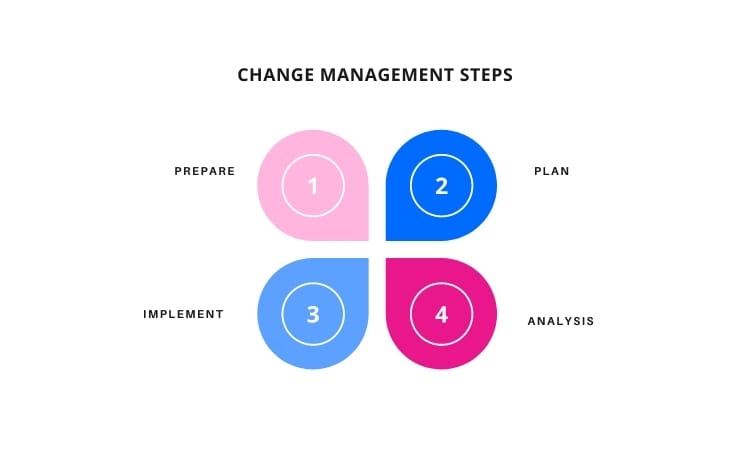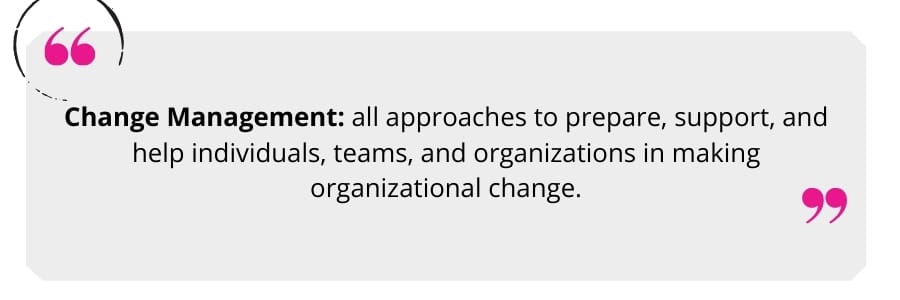“Keep up with organizational changes through top-tier tools”
As a business owner, you know that trying to control organizational changes is virtually impossible, as there are often unpredictable challenges and situations that escape your control. As an industry expert, however, you also know that staying ahead of change and trying to mitigate unpredictability is key. A great way to support these efforts is the implementation of change management tools and software solutions to support them. Let’s dive in!
What is Change Management?
According to Prosci, change management is the discipline that guides how we prepare, equip, and support individuals to successfully adopt change in order to drive organizational success and outcomes.
Change management focuses on the actions managers can take to influence people in their individual positions. As well as to provide a structural approach to organizational change and the workflows that allow seamless transitions.
As opposed to release management, “change management is more about the way people work with changing processes and tools whereas release management is more about the specific process behind delivering features and services to production.” You can learn more about how they work together here.
Change Management Process Steps
The Harvard Business School has identified five steps in the implementation of change management as part of an organization’s business processes. This step-by-step approach will help guide your organizational changes to fruition.
Introducing employees to upcoming changes helps create a cultural change and an understanding of what needs to be accomplished and why. This is the step when you’ll want to present problems to be solved, timeline, expectations, and tools to be used.
2. Craft a vision and plan for change
To help you craft a vision and plan for change, you should answer four key questions:
-
- What goals does this change help the organization work toward?
- What are our key performance indicators and how will we measure success?
- Who will we oversee the task of implementing change? Do we need to assign a project manager?
- What’s the scope of the project?
3. Implement the changes
Now is time to put your plan into practice and start taking steps towards change. The management process must account for setting short and long-term goals, staying on track with the original plan, and keeping employees empowered to mitigate and prevent roadblocks. Transparency and repeated communication are the best policy when implementing changes.
4. Embed changes with company culture and practices
Once the organizational change in question has been implemented, it’s easy to fall back into old habits and revert to old mistakes. In order for change to be truly efficient — especially when it comes to new software and tools — it’s important to analyze how change is impacting culture and continue to encourage employees to embrace improvements.
→ What you need to know about Business Process Analysis
→ Workflow Analysis: Best practices and Tools for efficiency
5. Review progress and analyze results
By now you’ve heard us talk about the importance of data analysis over and over, and change management is no exception. Whether you have implemented a new management solution, or you’ve adapted internal processes to make room for change, the only way to measure success is to review progress and analyze results. If you answered the questions on step one thoroughly, this step should be easy, and give you nothing but useful, relevant information.
Change Management Best Practices
Once you’ve followed the steps above, you can start refining the change management process and implement best practices to improve the workflow. Recent articles have identified four change management trends to follow:
1. Greater awareness and support as development teams increase reliance on change management tools.
2. Broader and more frequent application. Many organizations are choosing to use formal change management methodologies that provide structure and consistency, allowing for easy adoption.
3. Increase in change management maturity, meaning that companies are expected to appoint a Change Management Officer or an executive team to oversee organizational change management.
4. Greater need for education and training as employees expect and desire increased knowledge and more relevant roles to effect change.
What are Change Management Tools and their importance?
According to Whatfix, “Change management tools are pieces of software that companies use during periods of organizational change to make the process as smooth and seamless as possible for employees, managers, and customers. Of course, just as there are different types of organizational change, there are also many different types of change management tools.”
In simpler words, change management tools can help organizations like yours manage strategic transformational change (digital transformation is a great example), structural changes like mergers and acquisitions, remedial changes, and even people-centric changes, like new hires and changes to roles and responsibilities. It can also support managers with training programs and account representatives in their customer support efforts.
You now know the definition of a detailed process for change management, but what are the change management tools that can support these changes? The main tools we’ve identified are:
- Flowcharts/ Process Maps
- ADKAR Analysis
- Culture Mapping
- Force Field Analysis
- Stakeholder Analysis
- Kotter’s 8 Step Change Model
- Lewin’s Change Model
- Gantt Charts
Even though they are all different in their own way, the main goal for each tool is to allow managers to increase knowledge and resources and support your work at every phase of the change process. Through the usage of these tools, organizations are able to better plan how change will be implemented and measured, how employees will be empowered and how problem management will be approached.
For those who are focused in service management, taking advantage of these tools allows for companies to maintain a seamless process and keep a customer-centric culture without interruptions.
→ What you need to know about frictionless Customer Onboarding
Features of the Best Change Management Tools
In addition to the tools above, there are available IT Service Management (ITSM) Solutions that will support your change workflows and effectively manage implementation. Some features you should consider when searching for a supporting software solution are:
Infrastructure library support: An infrastructure library is a set of detailed practices for IT service management that focuses on aligning IT services with the needs of business. It’s important to find a solution that aligns with your needs and supports both your company goals and your backend processes.
Functionalities for managing tracking: Comparing the project plan with the actual advance of the project will help you adjust your timeline and stay on track. Make sure to look for a solution that has robust tracking and reporting functionalities to help you maintain a 360-degree view of your project.
Service portal: We often talk about the importance of choosing companies that provide top-notch customer service for their customers. This is especially important for change management tools, where you should aim to have a dedicated account representative and a service portal where you can manage tickets, access FAQs and get the resources you need to keep up with change.
Service desk for incident resolution: Much like service portals, service desks are another way in which companies maintain strong relationships with their customers and accompany them through every step. A change management solution that offers a service desk with incident resolution will save you headaches in the future.






